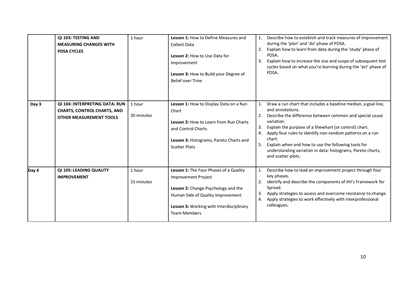
10
QI 103: TESTING AND
MEASURING CHANGES WITH
PDSA CYCLES
1 hour Lesson 1: How to Define Measures and
Collect Data
Lesson 2: How to Use Data for
Improvement
Lesson 3: How to Build your Degree of
Belief over Time
1. Describe how to establish and track measures of improvement
during the 'plan' and 'do' phase of PDSA.
2. Explain how to learn from data during the 'study' phase of
PDSA.
3. Explain how to increase the size and scope of subsequent test
cycles based on what you're learning during the 'act' phase of
PDSA.
Day 3 QI 104: INTERPRETING DATA: RUN
CHARTS, CONTROL CHARTS, AND
OTHER MEASUREMENT TOOLS
1 hour
30 minutes
Lesson 1: How to Display Data on a Run
Chart
Lesson 2: How to Learn from Run Charts
and Control Charts
Lesson 3: Histograms, Pareto Charts and
Scatter Plots
1. Draw a run chart that includes a baseline median, a goal line,
and annotations.
2. Describe the difference between common and special cause
variation.
3. Explain the purpose of a Shewhart (or control) chart.
4. Apply four rules to identify non-random patterns on a run
chart.
5. Explain when and how to use the following tools for
understanding variation in data: histograms, Pareto charts,
and scatter plots.
Day 4 QI 105: LEADING QUALITY
IMPROVEMENT
1 hour
15 minutes
Lesson 1: The Four Phases of a Quality
Improvement Project
Lesson 2: Change Psychology and the
Human Side of Quality Improvement
Lesson 3: Working with Interdisciplinary
Team Members
1. Describe how to lead an improvement project through four
key phases.
2. Identify and describe the components of IHI's Framework for
Spread.
3. Apply strategies to assess and overcome resistance to change.
4. Apply strategies to work effectively with interprofessional
colleagues.